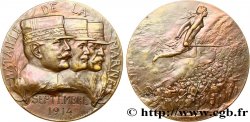You must signin and be an approved bidder to bid, LOGIN TO BID. Accounts are subject to approval and the approval process takes place within 48 hours. Do not wait until the day a sale closes to register. Clicking on « bid » constitutes acceptance of the terms of use of cgb.fr private e-auctions.
Bids must be placed in whole Euro amounts only. The sale will start closing at the time stated on the item description; any bids received at the site after the closing time will not be executed. Transmission times may vary and bids could be rejected if you wait until the last second. For further information ckeck the E-auctions F.A.Q.
NO BUYER'S FEE.
NO BUYER'S FEE.
| Estimate : | 85 € |
| Price : | 58 € |
| Maximum bid : | 63 € |
| End of the sale : | 20 January 2020 18:35:30 |
| bidders : | 6 bidders |
Type : Médaille, Bataille de la Marne
Date: c.1914
Metal : bronze
Diameter : 68,24 mm
Orientation dies : 12 h.
Engraver LEGASTELOIS Julien Prosper (1855-1931)
Weight : 157,92 g.
Edge : lisse + corne BRONZE
Puncheon : corne BRONZE
Coments on the condition:
Patine hétérogène avec des traces de manipulation. Exemplaire conservé dans une boîte jaune
Obverse
Obverse legend : BATAILLE - DE LA - MARNE // SEPTEMBRE / 1914.
Obverse description : Buste des trois généraux impliqués dans la bataille de la Marne. Signé : J.P. LEGASTELOIS.
Reverse
Reverse legend : ANÉPIGRAPHE.
Reverse description : Champ de bataille avec les armées survolées par la Victoire sous les traits de Marianne, armée d’une épée. Signé : J.P. LEGASTELOIS.
Commentary
Julien Prosper Joseph Marie Edmond Legastelois, dit Julien Prosper Legastelois, est un sculpteur et médailleur français, né à Paris le 24 mai 1855, et mort dans la même ville en 1931.
Cette médaille commémore les 2 batailles de la Marne avec la victoire de 1918 au revers et les trois portraits des généraux J. Joffre, M.-J. Maunoury et J. Gallieni.
La première bataille de la Marne, souvent identifiée comme « la bataille de la Marne » a eu lieu du 5 septembre 1914 au 12 septembre 1914 entre d'une part l'armée allemande et d'autre part l'armée française et le corps expéditionnaire britannique. Cette bataille doit être distinguée de la seconde bataille de la Marne, qui se déroula en juillet 1918.
Les combats se déroulèrent le long d'un arc-de-cercle de 225 km à travers la Brie, la Champagne et l'Argonne, limités à l'ouest par le camp retranché de Paris et à l'est par la place fortifiée de Verdun. Ce champ de bataille est subdivisé en plusieurs batailles plus restreintes : à l'ouest les batailles de l'Ourcq et des deux Morins, au centre les batailles des marais de Saint-Gond et de Vitry, et à l'est la bataille de Revigny.
Au cours de cette bataille décisive, les troupes franco-britanniques arrêtent puis repoussent les Allemands, mettant ainsi en échec le plan Schlieffen (revu par Moltke) qui prévoyait l'invasion rapide de la France en passant par la Belgique, pour éviter les fortifications françaises de l'Est et ensuite se reporter contre la Russie. La retraite allemande se termine sur la rive droite de l'Aisne dès le 14 septembre, ce qui déclenche la bataille de l'Aisne..
Julien Prosper Joseph Marie Edmond Legastelois, known as Julien Prosper Legastelois, was a French sculptor and medalist, born in Paris on May 24, 1855, and died in the same city in 1931..
This medal commemorates the two battles of the Marne with the 1918 victory on the reverse and the three portraits of Generals J. Joffre, M. -J. Maunoury and J. Gallieni.
The First Battle of the Marne, often referred to as \\\"The Battle of the Marne,\\\" took place from 5 September 1914 to 12 September 1914 between the German Army and the French Army and the British Expeditionary Force.. This battle must be distinguished from the Second Battle of the Marne, which took place in July 1918.
The fighting took place along a 225 km arc through Brie, Champagne and Argonne, limited to the west by the entrenched camp of Paris and to the east by the fortified town of Verdun.. This battlefield is subdivided into several smaller battles: to the west the battles of the Ourcq and the two Morins, in the center the battles of the marshes of Saint-Gond and Vitry, and to the east the battle of Revigny.
During this decisive battle, the Franco-British troops stopped and then pushed back the Germans, thus thwarting the Schlieffen Plan (revised by Moltke) which planned the rapid invasion of France via Belgium, to avoid the French fortifications in the East and then turn against Russia.. The German retreat ended on the right bank of the Aisne on September 14, triggering the Battle of the Aisne..
Cette médaille commémore les 2 batailles de la Marne avec la victoire de 1918 au revers et les trois portraits des généraux J. Joffre, M.-J. Maunoury et J. Gallieni.
La première bataille de la Marne, souvent identifiée comme « la bataille de la Marne » a eu lieu du 5 septembre 1914 au 12 septembre 1914 entre d'une part l'armée allemande et d'autre part l'armée française et le corps expéditionnaire britannique. Cette bataille doit être distinguée de la seconde bataille de la Marne, qui se déroula en juillet 1918.
Les combats se déroulèrent le long d'un arc-de-cercle de 225 km à travers la Brie, la Champagne et l'Argonne, limités à l'ouest par le camp retranché de Paris et à l'est par la place fortifiée de Verdun. Ce champ de bataille est subdivisé en plusieurs batailles plus restreintes : à l'ouest les batailles de l'Ourcq et des deux Morins, au centre les batailles des marais de Saint-Gond et de Vitry, et à l'est la bataille de Revigny.
Au cours de cette bataille décisive, les troupes franco-britanniques arrêtent puis repoussent les Allemands, mettant ainsi en échec le plan Schlieffen (revu par Moltke) qui prévoyait l'invasion rapide de la France en passant par la Belgique, pour éviter les fortifications françaises de l'Est et ensuite se reporter contre la Russie. La retraite allemande se termine sur la rive droite de l'Aisne dès le 14 septembre, ce qui déclenche la bataille de l'Aisne..
Julien Prosper Joseph Marie Edmond Legastelois, known as Julien Prosper Legastelois, was a French sculptor and medalist, born in Paris on May 24, 1855, and died in the same city in 1931..
This medal commemorates the two battles of the Marne with the 1918 victory on the reverse and the three portraits of Generals J. Joffre, M. -J. Maunoury and J. Gallieni.
The First Battle of the Marne, often referred to as \\\"The Battle of the Marne,\\\" took place from 5 September 1914 to 12 September 1914 between the German Army and the French Army and the British Expeditionary Force.. This battle must be distinguished from the Second Battle of the Marne, which took place in July 1918.
The fighting took place along a 225 km arc through Brie, Champagne and Argonne, limited to the west by the entrenched camp of Paris and to the east by the fortified town of Verdun.. This battlefield is subdivided into several smaller battles: to the west the battles of the Ourcq and the two Morins, in the center the battles of the marshes of Saint-Gond and Vitry, and to the east the battle of Revigny.
During this decisive battle, the Franco-British troops stopped and then pushed back the Germans, thus thwarting the Schlieffen Plan (revised by Moltke) which planned the rapid invasion of France via Belgium, to avoid the French fortifications in the East and then turn against Russia.. The German retreat ended on the right bank of the Aisne on September 14, triggering the Battle of the Aisne..








 Report a mistake
Report a mistake Print the page
Print the page Share my selection
Share my selection Ask a question
Ask a question Consign / sell
Consign / sell
 Full data
Full data















